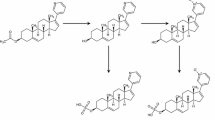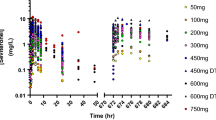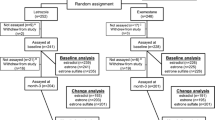Abstract
Estramustine phosphate (estramustine phosphate sodium), a carbamate ester combining 17β-estradiol and nor-nitrogen mustard, is a cytotoxic drug used in the treatment of advanced prostatic carcinoma. Because of the radiosensitising effect of this drug there has been a recent increase in interest concerning estramustine phosphate and its clinical use. It has also been found that the early recommendations of drug administration together with food or milk were inappropriate, since calcium containing food and antacids hamper drug uptake. This may have obscured results from earlier clinical studies with estramustine phosphate. Estramustine phosphate is currently being re-evaluated for the treatment of other tumours such as glioma and mammary carcinoma.
This review summarises the present relatively limited knowledge concerning the pharmacokinetic and pharmacodynamic aspects of estramustine phosphate and its metabolites.
Similar content being viewed by others
References
von Schoultz E, Lundblad D, Bergh J, et al. Estramustine binding protein and anti-proliferative effect of estramustine in human glioma cell lines. Br J Cancer. 1988; 58: 326–9.
Piepmeier JM, Keefe DL, Weinstein MA, et al. Estramustine and estrone analogs rapidly and reversibly inhibit deoxyribonucleic acid synthesis and alter morphology in cultured human glioblastoma cells. Neurosurgery. 1993; 32: 422–31.
Bergenheim AT. Estramustine-binding protein and cytotoxic effect of estramustine in glioma [dissertation]. Umeå: University of Umeå, 1994.
Bergenheim AT, Olofsson A, Ståhl A, et al. Prognostic implications of estramustine-binding protein in astrocytoma. Int J Oncol. 1995; 7: 349–52.
Yoshida D, Cornell-Bell A, Piepmeier JM. Selective antimitotic effects of estramustine correlate with its antimicrotubule properties on glioblastoma and astrocytes. Neurosurgery. 1994; 34: 863–8.
Forsgren B, Björk P, Carlström K, et al. Purification and distribution of a major protein in rat prostate that binds estramustine, a nitrogen mustard derivate of estradiol-17β. Proc Natl Acad Sci. 1979; 76: 3149–53.
Björk P, Fritjofsson Å, Hartley-Asp B. Uptake and binding of estramustine and estromustine, metabolites of estramustine phosphate (Estracyt), in the human prostate, and new aspects on the cytotoxic activity of estramustine phosphate in vitro. In: Harzmann R, editor. Experimentelle urologie. Berlin: Springer Verlag, 1985: 341–53.
Björk P, Flüchter S, Nelde H. Estramustine-binding protein: a marker for effect of therapy in prostatic carcinoma? Scand J Urol Nephrol 1988; Suppl. 107: 59–64.
Björk P, Borg Å, Fernö M, et al. Expression and partial characterization of estramustine-binding protein in human breast cancer and malignant melanoma. Anticancer Res. 1991; 11: 1173–82.
Norlén BJ, Andersson S-B, Björk P, et al. Uptake of estramustine phosphate (Estracyt) metabolites in prostatic cancer. J Urol. 1988; 140: 1058–62.
Flüchter SH, Nelde HJ, Björk P, et al. Effect of treatment on the expression of estramustine-binding protein (EMBP) in prostatic cancer patients: an immunohistochemical study. Prostate. 1989; 14: 27–43.
von Schoultz E, Bergenheim T, Grankvist K, et al. Estramustine binding protein in human brain tumor tissue. J Neurosurg. 1991; 74: 962–4.
von Schoultz E, Carlström K, Henriksson R, et al. Estramustine-binding protein in primary tumors and metastasis of malignant melanoma. Melanoma Res. 1994; 4: 401–5.
Bergenheim AT, Björk P, Bergh J, et al. Estramustine-binding protein and specific binding of estramustine in astrocytoma. Cancer Res. 1994; 54: 4974–9.
Hartley-Asp B. Estramustine-induced mitotic arrest in two human prostatic carcinoma cell lines DU 145 and PC-3. Prostate. 1984; 5: 93–100.
Stearns M, Tew K. Antimicrotubule effects of estramustine, an antiprostatic tumor drug. Cancer Res. 1985; 45: 3891–7.
Eklöv S, Nilsson S, Larsson A, et al. Evidence for a non-estrogenic cytostatic effect of estramustine on human prostatic carcinoma cells in vivo. Prostate. 1992; 20: 43–50.
Hartley-Asp B, Kruse E. Nuclear protein matrix as a target for estramustine-induced cell death. Prostate. 1986; 9: 387–95.
Grankvist K, von Schoultz E, Henriksson R. New aspects on the cytotoxicity of estramustine-involement of free-oxygen radicals. Int J Exp Clin Chemother. 1988; 1: 37–42.
Henriksson R, Bjermer L, von Schoultz E, et al. The effect of estramustine on microtubuli is different from the direct action via oxygen radicals on DNA and cell membrane. Anticancer Res. 1990; 10: 303–10.
von Schoultz E, Grankvist K, Gustavsson H, et al. Effects of estramustine on DNA and cell membrane in malignant glioma cells. Acta Oncol. 1991; 30: 719–23.
Pienta KJ, Lehr JE. Inhibition of prostate cancer growth by estramustine and etoposide: evidence for interaction at the nuclear matrix. J Urol. 1993; 149: 1622–5.
Sandström PE, Jonsson Ö, Grankvist K, et al. Identification of potassium flux pathways and their role in the cytotoxicity of estramustine in human malignant glioma, prostatic carcinoma, and pulmonary carcinoma cell lines. Eur J Cancer. 1994; 12: 1822–6.
Vallbo C, Bergenheim T, Bergh A, et al. DNA fragmentation induced by the antimitotic drug estramustine in malignant rat glioma but not in normal brain: suggesting an apoptotic cell death. Br J Cancer. 1995; 71: 717–20.
Bergenheim AT, Zackrisson B, Elfverson J, et al. Radiosensitizing effect of estramustine in gliomas in vitro and in vivo. J Neurooncol. 1995; 23: 191–200.
Widmark A, Bergh A, Damber J-E, et al. Estramustin potentierar Stråleffekten av prostatacancer hos råtta [abstract]. Swedish Medical Society Annual Meeting. Proc Swedish Physicans Assoc. 1991; 100(2): 268.
Widmark A, Damber J-E, Bergh A, et al. Estramustine potentiates the effects of irradiation on the Dunning (R3327) rat prostatic adenocarcinoma. Prostate. 1994; 24: 79–83.
Yoshida D, Piepmeier J, Weinstein M. Estramustine sensitizes human glioblastoma cells to irradiation. Cancer Res. 1994; 54: 1415–7.
Folca PJ, Glascock RF, Irvine WT. Studies with tritium-labelled hexoestrol in advanced breast cancer. Lancet 1961; II: 796.
Fex HJ, Högberg KB, Könyves I, et al. Certain steroid N-bis-(halo-ethyl)-carbamates, US patent 3,299,104. 1967 Jan.
Fex H, Högberg B, Könyves I. Estramustine phosphate: historical review. J Urol. 1984; 23: 4–5.
Danielli JF. Br Emp Cancer Campaign Annual Rept, 1959: 575.
Groupe Europeen du Cancer du Sein. Essai clinique du phénol bis(2-chloroéthyl) carbamate d’oestradiol dans le cancer mammaire en phase avancée. Eur J Cancer. 1969; 5: 1–4.
Plym-Forshell G, Nilsson H. The distribution of radioactivity after administration of labelled estramustine phosphate (Estracyt), estradio-17β-phosphate and estradiol to rats. Acta Pharmacol Toxicol. 1974; 35 Suppl. 1: 28.
Jönsson G. Cytotoxic agents in the treatment of prostatic carcinoma. Life Sci Monogr. 1969; 1: 145–59.
Klein D. Behandlung mit estramustinphosphat bei fortgeschrittenen Prostatacarzinomen. Wiener Med Wochenschrift. 1971; 122: 458–60.
Lindberg B. Treatment of rapidly progressing prostatic carcinoma with estracyt. J Urol. 1972; 108: 303–6.
Jönsson G, Olsson AM, Luttrop W, et al. Treatment of prostatic carcinoma with various types of estrogen derivatives. Vitam Horm. 1975; 33: 351–76.
Forsgren B, Gustafsson J-A, Pousette A, et al. Binding characteristics of a major protein in rat ventral prostate cytosol that interacts with estramustine, a nitrogen mustard derivate of 17 β-estradiol. Cancer Res. 1979; 39: 5155–64.
Björk P, Forsgren B, Gustafsson J-Å, et al. Partial characterization and ‘quantitation’ of a human prostatic estramustine binding protein. Cancer Res. 1982; 42: 1935–42.
Forsgren B, Björk P. Specific binding of estramustine to prostatic proteins. Urology. 1984; 23 Suppl. 6: 34–8.
Tew K, Hartley-Asp B. Cytotoxic properties of estramustine unrelated to alkylating and steroid constituents. J Urol. 1984; 23: 28–33.
Tew KD, Stearns ME. Hormone-independent, non-alkylating mechanism of cytotoxicity for estramustine. Urol Res. 1987; 15: 155–60.
von Schoultz E, Lundgren E, Henriksson R. Effects of estramustine and its constituents on human malignant glioma cells. Anticancer Res. 1990; 10: 693–6.
Gunnarsson PO, Andersson S-B, Johansson S-A, et al. Pharmacokinetics of estramustine phosphate (Estracyt®) in prostatic cancer patients. Eur J Clin Pharmacol. 1984; 26: 113–9.
Dixon R, Brooks M, Gill G. Estramustine phosphate: plasma concentrations of its metabolites following oral administration to man, rat, and dog. Res Comm Chem Pathol Pharmacol. 1980; 27: 17–29.
Andersson SB, Gunnarsson PO, Nilsson T, et al. Metabolism of estramustine phosphate in patients with prostatic carcinoma. Eur J Drug Metab Pharmacokinet. 1981; 6: 149–54.
Gunnarsson P-O, Plym-Forshell G, Fritjofsson Å, et al. Plasma concentrations of estramustine phosphate and its major metabolites in patients with prostatic carcinoma treated with different doses of estramustine phosphate (Estracyt®). Scand J Urol Nephrol. 1981; 15: 201–6.
Bergenheim AT, Gunnarsson PO, Edman K, et al. Uptake and retention of estramustine and the presence of estramustinebinding protein in malignant brain tumors in humans. Br J Cancer. 1993; 67: 358–61.
Kirdani RY, Mittelman A, Murphy GP, et al. Studies on phenolic steroids in human subjects. XIV: fate of a nitrogen mustard of estradiol-17β. J Clin Endocrinol Metab. 1975; 41: 305–18.
Plym-Forshell G, Müntzing J, Ek A, et al. The absorption, metabolism and excretion of estracyt (NSC89199) in patients with prostatic cancer. Invest Urol. 1976; 14: 128–31.
Gunnarsson PO, Andersson S-B, Sandberg ÅA, et al. Accumulation of estramustine in adipose tissue of rats and humans. Cancer Chemother Pharmacol. 1991; 28: 361–4.
Gunnarsson PO, Davidsson T, Andersson S-B, et al. Impairment of estramustine phosphate absorption by concurrent milk and food intake. Eur J Clin Pharmacol. 1990; 38: 189–93.
Forsgren B, Högberg B. Binding of a nitrogen mustard devivative of estradiol to rat ventral prostate gland and cytosol. Res Steroids. 1977; 7: 431–3.
H0isaeter PA. In vitro binding of tritiated hormone-cytostatic complexes in the cytosol of various rat tissues and the incorporation of these complexes into nuclei. Scand J Urol Nephrol. 1977; 11: 135–41.
Heyns W, De Moor P. Prostatic binding protein: a steroid-binding protein secreted by rat prostate. Eur J Biochem. 1977; 78: 221–30.
Chen C, Schilling K, Hiipakka RA, et al. Prostate a-protein: isolation and characterization of the polypeptide components and cholesterol binding. J Biol Chem. 1982; 257: 116–21.
Forsgren B, Högberg B, Gustafsson J-A, et al. Binding of estramustine, a nitrogen mustard derivative of estradiol-17β, in cytosol from rat ventral prostate. Acta Pharm Suec. 1978; 15: 23–32.
Heyns W, Peeters B, Mous J, et al. Purification and characterisation of prostatic binding protein and its subunits. Eur J Biochem. 1978; 89: 181–6.
Högberg B, Björk P, Carlström K, et al. The interaction of steroidal alkylating agents with binding components in the soluble fraction of the prostate. In: Murphy GP, Sandberg AA, editors. Prostate cancer and hormone receptors. New York: Alan R Liss Inc, 1979: 181–99.
Bichler K-H, Flüchter SH, Nelde HJ, et al. An immunohistochemical technique for localization and semiquantitation of estramustine-binding protein (EMBP) in rat and human prostate. Prostate. 1989; 14: 13–25.
Björk P. Expression of estramustine-binding protein (EMBP) in normal and neoplastic tissues [doctorial dissertation]. Lund: Lund University, 1991.
Bergh J, Björk P, Westlin J-E, et al. Expression of an estramustine-binding associated protein (EMBP) in human lung cancer cell lines. Cancer Res. 1988; 48: 4615–9.
Björk P, Isaacs JT, Hartley-Asp B. Estramustine binding protein (EMBP) in rat R3327 Dunning tumors: partial characterization and effect of hormonal withdrawal, hormonal replacement and cytotoxic treatment on its expression. Prostate. 1991; 18: 181–200.
Bergenheim AT, Hartman M, Bergh J, et al. Expression of estramustine-binding protein in ependymomas and in human and developing rat ependymal cells. J Neurooncol. 1994; 22: 45–53.
Hartley-Asp B, Gunnarsson PO. Growth and cell survival following treatment with estramustine, nor-nitrogen mustard, estradiol and testosterone of a human prostatic cancer cell line (DU 145). J Urol. 1982; 127: 818–22.
Sheridan VR, Speicher LA, Tew KD. The effects of estramustine on metaphase and anaphase in DU 145 prostatic carcinoma cells. Eur J Cell Biol. 1991; 54: 268–76.
Eklöv S, Essand M, Carlsson J, et al. Radiation sensitization by estramustine: studies in cultured human prostatic cancer cells. Prostate. 1992; 21: 287–95.
von Schoultz E, Gunnarsson PO, Henriksson R. Uptake, metabolism and proliferative effect of estramustine phosphate in human glioma cell lines. Anticancer Res. 1989; 9: 1713–6.
von Schoultz E. Malignant glioma: experimental studies with an estrogen-linked cytostatic [doctoral dissertation]. Umeå: Univsersity of Umeå, 1990.
Bergenheim AT, Elfverson J, Gunnarsson PO, et al. Cytotoxic effect and uptake of estramustine in a rat glioma model. Int J Oncol. 1994; 5: 293–9.
Wallin M, Deinum J, Hartley-Asp B. Estramustine phosphate inhibits microtubule assembly by binding to the mictrotubule-associated proteins. Ann NY Acad Sci. 1986; 466: 423–5.
Stearns M, Tew K. Estramustine binds to MAP-2 to inhibit microtubule assembly in vitro. J Cell Sci. 1988; 89: 331–42.
Moraga D, Rivas-Berrios A, Farìas G, et al. Estramustine-phosphate binds to a tubulin binding domain on microtubule-associated proteins MAP-2 and TAU. Biochem Biophys Acta. 1992; 1121: 97–103.
Dahllöf B, Billström A, Cabrai F, et al. Estramustine depolymerizes microtubules by binding to tubulin. Cancer Res. 1993; 53: 4573–81.
Bjermer L, von Schoultz E, Norberg B, et al. Estramustine inhibits monocyte phagocytosis. Prostate. 1988; 13: 49–55.
Engström KG, Grankvist K, Henriksson R. Early morphological detection of estramustine cytotoxicity measured as alteration in cell size and shape by a new technique of microperifusion. Eur J Cancer. 1991; 27: 1288–95.
Gupta R. Cross-resistance of nocodazole-resistant mutants of CHO cells toward other microtubule inhibitors: similar mode of action of benzimidazole carbamate derivatives and NSC 181928 and TN-16. Mol Pharmacol. 1986; 30: 142–8.
Jönsson G, Högberg B, Nilsson T. Treatment of advanced prostatic carcinoma with estramustine phosphate (Estracyt®). Scand J Urol Nephrol. 1977; 11: 231–8.
Vallbo C, Bergenheim AT, Henriksson R. Apoptosis induced in malignant glioma by estramustine in the clinical situation [abstract]. J Neurooncol. 1996; 30: 106.
Vallbo C, Bergenheim T, Bergström P, et al. Apoptotic cell death induced by estramustine in a subpopulation of glioma cells in patients with malignant glioma. Cancer Res. In press.
Sinclair WK, Morton RA. X-ray sensitivity during the cell generation cycle of cultured Chinese hamster cells. Radiat Res. 1966; 29: 450–74.
Littbrand B, Révész L. The effect of oxygen on cellular survival and recovery after radiation. Br J Radiol. 1969; 42: 914–24.
Johansson M, Bergenheim AT, Henriksson R, et al. Tumor blood flow and cytotoxic effects of estramustine and its constituents in a rat glioma. Neurosurgery. 1997; 41: 237–44.
Kjaer TB, Nilsson T, Madsen PO. Effect of estramustine phosphate on plasma testosterone during treatment of carcinoma of the prostate. Urology. 1975; 5: 802–4.
Küss R, Khoury S, Richard F, et al. Estramustine phosphate in the treatment of advanced prostatic cancer. Br J Urol. 1980; 52: 29–33.
McMillin JM, Seal US, Doe RP. Effect of oral estramustine phosphate on pituitary, gonodal, and adrenal function in the green monkey. Invest Urol. 1977; 15: 151–4.
Korfsmeier K-H, Schulte-Fischediek R. Effects of estramustin phosphate on hypothalamus and hypophysis of the rat [abstract]. Acta Anatomica. 1981; 111: 78.
Lerclercq G, Heuson J-C. Biochemical assays for the selection of cytotoxic-linked estrogens with potential therapeutic activity. Cancer Treat Rep. 1978; 62: 1255–7.
Slack NH, Murphy GP. Clinical toxicity and long-term results of Emcyt therapy for prostatic cancer. Urology 1984; Suppl. 23: 73–7.
Blomböck M, Hedlund PO, Söwe U. Changes in blood coagulation and fibrinolysis in patients on different treatment regimens for prostate cancer: predictors for cardiovascular complications? Thrombosis Res 1988 Jan; 49(1): 11–121.
Müntzing J, Gunnarsson K. Preclinical pharmacology and toxicology of estramustine phosphate. Urology. 1984; 23 Suppl. 6: 6–10.
Sumi N, Yoshida H, Nakai K, et al. Estramustine phosphate disodium (EMP). Oyo Yakuri. 1980; 20: 757–802.
Sumi N, Kameyama K, Nishiguchi Y, et al. Estramustine phosphate disodium (EMP). Oyo Yakuri. 1981; 21: 549–86.
Author information
Authors and Affiliations
Rights and permissions
About this article
Cite this article
Bergenheim, A.T., Henriksson, R. Pharmacokinetics and Pharmacodynamics of Estramustine Phosphate. Clin Pharmacokinet 34, 163–172 (1998). https://doi.org/10.2165/00003088-199834020-00004
Published:
Issue Date:
DOI: https://doi.org/10.2165/00003088-199834020-00004




